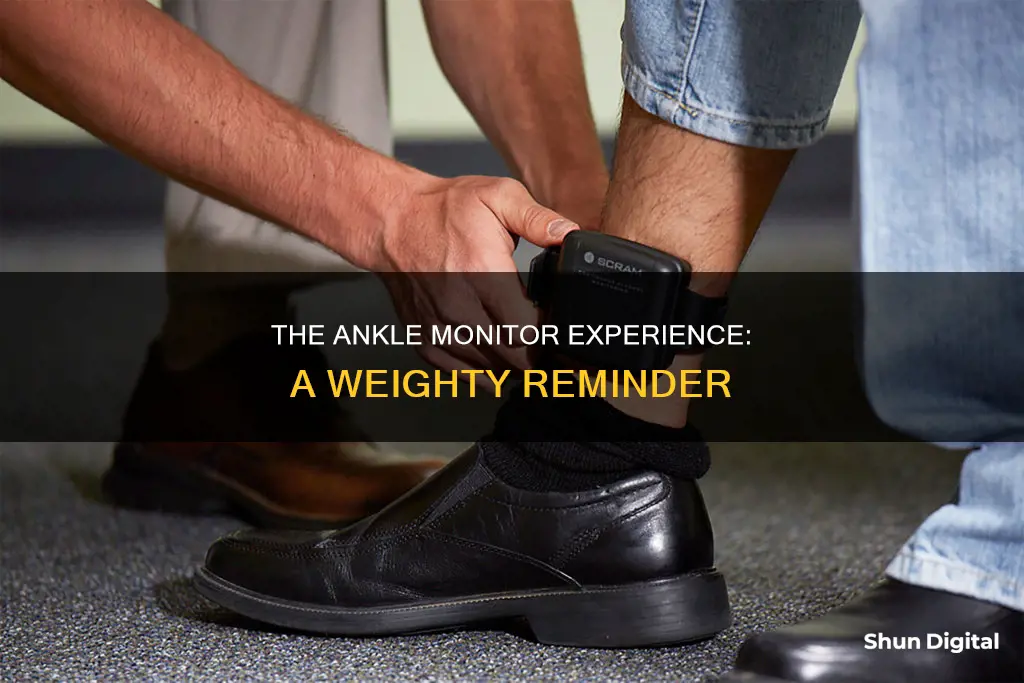
Ankle monitors are tracking devices worn by individuals who have been sentenced to restricted travel or activities. They are used as an alternative to jail time, allowing people to remain free while awaiting trial or as a condition of probation. The monitors help ensure that individuals comply with the terms of their sentence, such as maintaining a certain distance from a victim or refraining from drinking alcohol. They can also be used to track the location of individuals and ensure they stay within designated areas. While ankle monitors may offer an alternative to incarceration, they also introduce new challenges and restrictions for wearers, impacting their daily lives and liberties. The experience of wearing an ankle monitor can vary depending on the specific conditions and rules set by the court.
| Characteristics | Values |
|---|---|
| Purpose | To ensure the wearer stays within boundaries set by the court |
| Who wears them | People awaiting trial, those considered a danger to the community or a flight risk |
| Alternative to | Jail sentence, pre-trial detention, or as a condition of probation |
| Rules | Sticking to a specific area, avoiding certain people, adhering to a curfew, refraining from drinking alcohol |
| Alcohol detection | Secure Continuous Remote Alcohol Monitor (SCRAM) bracelet can detect alcohol in a person's sweat |
| Cost | $10 to $35 per day |
| Charging | Needs to be charged for hours every day |
| Weight | Fairly lightweight |
| Waterproof | Yes |
| Airport security | Not permitted |
| Size | About the size of a pager |
| Strap | Tamper-proof |
| Tracking | Radio frequency (RF) and GPS |
| Alerts | Vibrates and emits a loud tone if the wearer goes outside the designated area |
What You'll Learn

Ankle monitors can be used as an alternative to jail time for non-violent crimes
Ankle monitors are increasingly being used as an alternative to traditional imprisonment, allowing individuals to serve their sentences while remaining in the community. They are often used for people who are on probation or parole, awaiting trial, or have been convicted of a non-violent crime and are considered low-risk.
Ankle monitors allow individuals to maintain their jobs, continue their education, and support their families, which can aid in their reintegration into society. They are also a more cost-effective option than incarceration, reducing costs for the state.
However, ankle monitors are not without their drawbacks. They can be uncomfortable and cause skin irritation. Individuals are subject to strict rules and regulations, and any violation can result in additional penalties or imprisonment. There are also financial implications, with individuals often required to pay daily fees to private companies for the use of the device.
In conclusion, while ankle monitors can be a viable alternative to jail time for non-violent crimes, it is important to carefully consider the advantages and disadvantages before implementing them. The offender's risk of reoffending and the nature of the crime must be taken into account when deciding if an ankle monitor is an appropriate punishment.
Removing the W221 Monitor: A Step-by-Step Guide
You may want to see also

They can be used to enforce sobriety
Ankle monitors are often used as a tool to enforce sobriety for individuals who are going through treatment or have been ordered by the court to remain alcohol-free. This method of monitoring can be highly effective in supporting individuals on their path to recovery and ensuring compliance with legal requirements. Here's how ankle monitors can be utilized to enforce sobriety:
For individuals in recovery from substance abuse, ankle monitors can provide a layer of accountability and support. These monitors are often equipped with alcohol-sensing technology that can detect the presence of alcohol through the individual's sweat. This feature allows for continuous remote monitoring of the person's sobriety. If the individual consumes alcohol, the monitor will detect it, and this information can be transmitted to the appropriate authorities or treatment providers. This real-time data provides an opportunity for swift intervention and support, which is crucial in the recovery process.
The continuous monitoring aspect of ankle bracelets helps create a structure that supports long-term sobriety. Individuals wearing these devices often feel a sense of accountability, knowing that their actions are being recorded and reviewed. This awareness can serve as a deterrent against relapsing. Additionally, the data collected from the ankle monitor can provide valuable insights into an individual's progress and challenges, allowing treatment providers to offer tailored support and interventions when needed.
In some cases, ankle monitors are court-ordered for individuals who have been convicted of alcohol-related offenses or who are on probation. The monitor serves as a condition of their release or probation, ensuring they maintain sobriety. If the individual violates the terms by consuming alcohol, they may face legal consequences, such as further restrictions on their freedom or even incarceration. This aspect of enforcement can provide a strong incentive for the individual to remain sober and comply with the court's requirements.
To ensure the effectiveness of ankle monitors in enforcing sobriety, regular calibration and testing are necessary. The devices must be accurately calibrated to detect alcohol consumption at the specified levels. Individuals wearing these monitors may be required to participate in regular testing, where they consume a controlled amount of alcohol under supervision to ensure the device is functioning properly. This process helps maintain the integrity of the monitoring program and provides assurance that the individual's sobriety is being accurately tracked.
In addition to alcohol monitoring, ankle bracelets can also facilitate location tracking. This feature can be advantageous in sobriety enforcement by creating geographical boundaries, often referred to as "geofencing." Treatment providers or authorities can establish specific areas that the individual should avoid, such as bars or known drug hotspots. If the person enters these restricted zones, alerts can be triggered, allowing for timely interventions and providing an additional layer of support for their sobriety journey.
Ankle monitors play a crucial role in enforcing sobriety, offering a combination of accountability, support, and, in some cases, legal enforcement. Through alcohol sensing, continuous monitoring, and location tracking, these devices provide a comprehensive approach to supporting individuals in their recovery. By utilizing ankle monitors, treatment providers and legal authorities can work together to create a structured environment that fosters long-term sobriety and helps individuals rebuild their lives.
Removing Dead Bugs from Your Monitor: A Step-by-Step Guide
You may want to see also

They are usually paid for by the wearer, which can be costly
The cost of an ankle monitor is usually shouldered by the wearer, and this can be expensive. The cost varies depending on location and income, with some states charging a sliding scale based on income. Typically, there is a daily usage fee of between $5 and $20, plus a one-time setup fee of $100 to $200. This means that the wearer could be paying hundreds of dollars per month. For example, in South Carolina, there is a setup fee of $179.50, plus a daily fee of $9.25. In Riverside County, California, the wearer must pay $7 per day for a regular unit and $12 per day for a cellular unit. In Augusta, Georgia, one wearer was paying $12 per day, plus a $50 setup fee and $39 per month to a probation company.
Some people argue that this additional financial burden is unfair, as it disproportionately affects poor defendants. In the case of Daehaun White, a 19-year-old from St. Louis, he was required to pay $10 per day for his ankle monitor, plus a $50 installation fee and $300 upfront. White had been earning minimum wage before his arrest, and his family struggled to keep up with bills. White's mother, Lakisha Thompson, felt that the court was forcing her to choose between getting her son out of jail and supporting the rest of her family.
Proponents of ankle monitors argue that they are a more humane and affordable alternative to jail. However, critics argue that they can lead to a form of "digital incarceration" or "e-carceration", where people are sent back to jail for minor technical violations, charging malfunctions, and false alarms. Additionally, the stigma, social isolation, and stress associated with wearing an ankle monitor can exacerbate depression and anxiety for the wearer.
Eradicating Resonance: Studio Monitor Optimization Techniques
You may want to see also

They are often used for repeat offenders
Ankle monitors are often used for repeat offenders as they provide an extra layer of supervision to help prevent them from committing further offences. They are also used for those awaiting trial who are considered a danger to the community or a flight risk.
Ankle monitors are also used as an alternative to a jail sentence. If an offender is deemed low-risk, they may be able to avoid jail time by wearing an ankle monitor. This is particularly common for those with substance abuse issues, as prison can be a detrimental environment for those struggling with addiction. Judges may opt for an alternative sentence, such as work release or electronic monitoring.
Ankle monitors are also used as a condition of probation, bail or parole. They can be used to ensure that an individual is adhering to the terms of their sentence, such as maintaining sobriety or staying within a certain distance of a victim.
The use of ankle monitors has been shown to be effective in deterring crime and reducing reoffending rates. A 2006 study of 75,661 Florida offenders placed on home detention found that those who wore electronic tags were 91.2% less likely to abscond and 94.7% less likely to commit new offences than unmonitored offenders.
Ankle monitors are typically strapped to the lower leg and are fairly lightweight and waterproof. They can be used in combination with GPS technology to track an individual's movements and ensure they are staying within the boundaries set by the court. If an individual attempts to remove their ankle monitor, an alert will be sent to the relevant authorities.
Finding Your Monitor's Response Time: Measuring in Milliseconds
You may want to see also

They are sometimes used for those awaiting trial
Ankle monitors are sometimes used for those awaiting trial. This is often the case when the court considers the individual a flight risk or a danger to the community. The device is used to ensure that the individual stays within the boundaries set by the court and does not get into further trouble.
The terms and conditions of wearing an ankle monitor can vary depending on the situation and the crime committed. Typically, individuals are required to stick to a specific area, such as staying within a certain radius of their home, and may be given a curfew. They may also be required to avoid certain people or places, such as maintaining a required distance from the victim in cases of domestic violence.
The ankle monitor is usually about the size of a pager and is strapped to the ankle with a tamper-proof band. It transmits a signal to a base unit, often located in the wearer's home, and is connected to a landline phone. If the wearer goes outside the designated area, the device vibrates and emits a loud tone, notifying them that they are about to violate the conditions of their release. If they do not return to the designated area, the device sends an alert to the authorities.
In addition to tracking location, ankle monitors can also be used to ensure the wearer is complying with court-ordered sobriety. A Secure Continuous Remote Alcohol Monitor (SCRAM) bracelet can detect alcohol in a person's sweat and alert authorities if they violate the terms of their release by drinking.
While ankle monitors are presented as an alternative to incarceration, some wearers describe them as a form of digital shackles that restrict their liberties. The devices can be bulky and require regular charging, with the battery lasting anywhere from 12 hours to 2-3 days. The costs of renting and maintaining the device can also be significant, ranging from $10 to $35 per day, and are often paid for by the wearer. This can pose a financial burden, especially for those from impoverished or marginalised communities.
Is Your Chromebook Being Monitored? Here's How to Tell
You may want to see also
Frequently asked questions
An ankle monitor is a device worn around the lower leg to track the movements of individuals who have been sentenced to restricted travel or activities.
The rules for wearing an ankle monitor vary depending on the situation and the jurisdiction. Generally, those who wear ankle monitors must adhere to specific conditions set by the court, such as sticking to a certain area, avoiding certain people, or adhering to a curfew.
Ankle monitors use GPS or radio frequency technology to track the wearer's location. The device transmits a signal to a base unit, typically located in the wearer's home, and alerts authorities if the wearer goes outside the designated area.
All ankle monitors have a way to detect if the device has been tampered with. If someone attempts to remove the monitor, it will trigger an alert and the authorities will be notified.
The cost of wearing an ankle monitor can vary depending on the jurisdiction and the individual's financial situation. In some cases, the wearer may have to pay daily or monthly fees, which can range from $10 to $35 per day.







